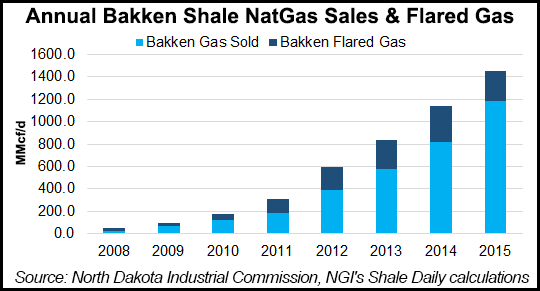Bakken Shale | NGI All News Access
Bakken Blamed for Rise in Global Ethane Emissions
The increase in global ethane emissions is the result of increased oil and natural gas activity in the Bakken Shale, according to University of Michigan (U-M) researchers.

While methane emissions receive most of the attention, researchers said their work shows ethane needs its share. Fugitive emissions with heavy natural gas composition, such as ethane, also impact methane assessments, according to the study published in the journal Geophysical Research Letters.
Bakken emissions observed in North Dakota and part of Montana were “10 to 100 times larger” than the reported inventories of the escaping gas, said the nine co-authors.
“Fugitive emissions from the Bakken shale illustrate [the] role of shale production in global ethane shift,” said the report, which was published online Tuesday.
Based on sampling for 12 days in May 2014, conducted via flyovers of the Bakken in a National Oceanic and Atmospheric Administration (NOAA) aircraft, the research team’s calculations put the Bakken ethane emission at about 250,000 tons/year, or 2% of the world’s ethane releases.
“The very heavy composition of raw gas in the Bakken Shale (42%) helps explain the relatively high emissions,” the authors noted. “Other shale plays in the United States have notably lower ratios.”
Considering other basins’ relative production and raw gas composition, “it is reasonable to suspect” that ethane emissions from the Eagle Ford Shale and Bakken represent a large fraction of the recent global shift in fugitive emissions, whereas drygas formations, such as Haynesville and Fayetteville shales, “likely play a modest role” in spite of their large gas production.
From 1984 through 2009, ethane levels in the atmosphere were steadily dropping, according to U-M’s Eric Kort, lead author and assistant professor of climate/space sciences and engineering. However, in 2010 a mountaintop sensor in Europe registered an ethane uptick in the atmosphere, causing researchers to take a closer look.
“Ethane concentrations have been on the rise ever since,” Kort said.
The co-authors, who included a NOAA scientist, said ethane is the globe’s second most abundant atmospheric hydrocarbon, exerting a strong influence on the Earth’s “tropospheric ozone” and reducing the atmosphere’s oxidative capacity.
While not directly related to the fugitive emissions issues, the distribution and sale of ethane has been a sub-set of the now profound commodity price slump gripping the oil and gas industry, with analyses of what this may or may not do to the U.S. ethane market (see Shale Daily, March 31, 2015). Many also are tracking the appetite for building more U.S. ethane production facilities (see Shale Daily, May 2, 2014).
© 2024 Natural Gas Intelligence. All rights reserved.
ISSN © 2577-9877 | ISSN © 2158-8023 |
